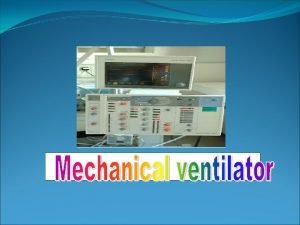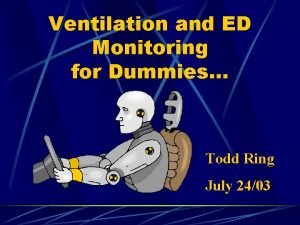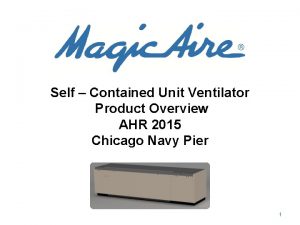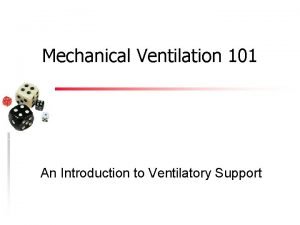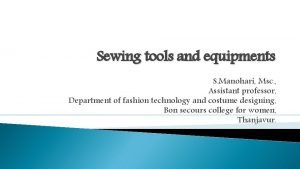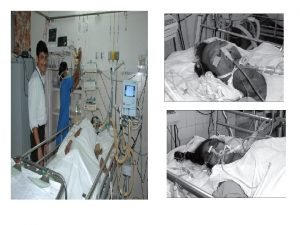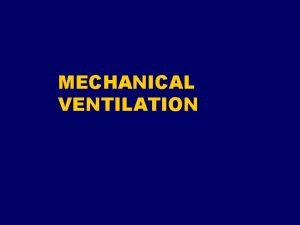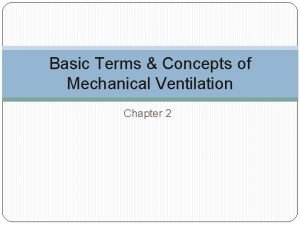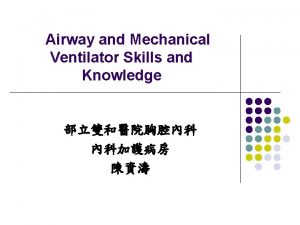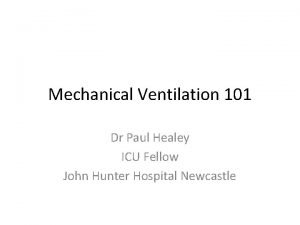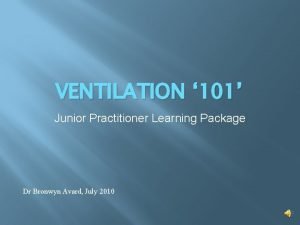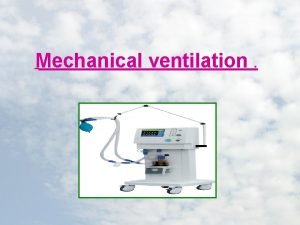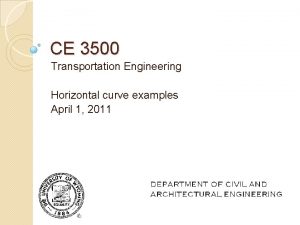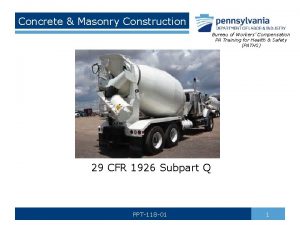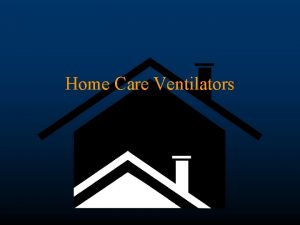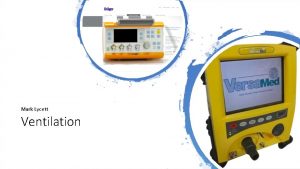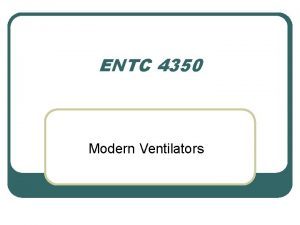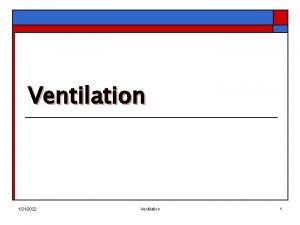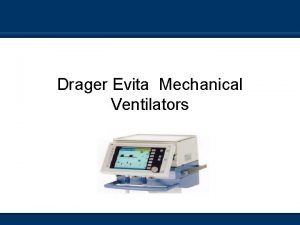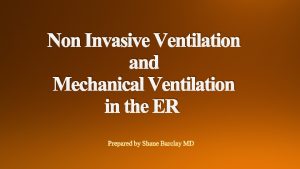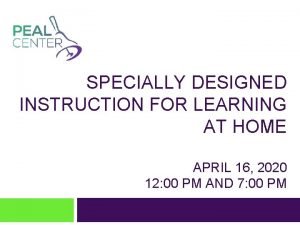Mechanical ventilation Mechanical Ventilation Ventilators are specially designed





















- Slides: 21

Mechanical ventilation.

. Mechanical Ventilation Ventilators are specially designed pumps that can support the ventilatory function of the respiratory system and improve oxygenation through application of high oxygen content gas and positive pressure.

Indication of mechanical ventilation : 1 - Cardiac or respiratory arrest 2 - Tachypnea or bradypnea with respiratory fatigue or impending arrest 3 - Acute respiratory acidosis 4 - Refractory hypoxemia 1. 0) 5 - Inability to protect the airway associated with depressed levels of consciousness 6 - Shock associated with excessive respiratory work 7 - Inability to clear secretions with impaired gas exchange or excessive respiratory work

Mode of mechanical ventilation : 1 - Assist Control Mode Ventilation (ACMV) An inspiratory cycle is initiated either by the patient’s inspiratory effort or, if no patient effort is detect within a specified time window, by a timer signal within the ventilator. Advantage : - Timer backup - Patient-vent - Synchrony - Patient controls - minute ventilation Disadvantage : - Not useful for weaning - Potential for dangerous respiratory alkalosis

2 - Synchronized Intermittent Mandatory Ventilation (SIMV) the patient is allowed to breathe spontaneously, i. e. , without ventilator assist, between delivered ventilator breaths. Advantage : - Timer backup - Useful for weaning. Disadvantage : - Potential dysynchrony

3 - Continuous Positive Airway Pressure (CPAP) Positive pressure applied at the end of expiration. Advantage : - Helps prevent atelectasis. Disadvantage : - No backup

4 - Pressure-Control Ventilation (PCV) During the inspiratory phase, a given pressure is imposed at the airway opening, and the pressure remains at this user-specified level throughout inspiration. Advantage : - System pressures regulated - Useful for barotrauma treatment - Timer backup Disadvantage : - Requires heavy sedation - Not useful for weaning

5 - Pressure-Support Ventilation (PSV) patients receive ventilator assist only when the ventilator detects an inspiratory effort. Advantage : - Good for weaning. Disadvantage : - No timer backup

6 - Positive end expiratory pressure ( PEEP) : Positive pressure applied at the end of expiration during ventilator breath. Advantage : - Improve oxygenation. Complication : - Decreased venous return - Barotrauma - Increased intracranial pressure

Criteria for institution of ventilatory support : Parameter Pulmonary function studies : - Respiratory rate (b/m) - Tidal volume (ml/kg body wt ) - Vital capacity (ml/kg body wt ) - Maximum inspiratory force ( cm H 2 o) ABG : - PH - Pa. O 2 ( mm. Hg ) - Pa. CO 2 ( mm. Hg ) Ventilation Normal range indicated > 35 <5 < 15 < 20 10 – 20 5– 7 65 – 75 75 - 100 < 7. 25 < 60 < 50 7. 35 – 7. 45 75 – 100 35 - 45

Common Ventilator settings / Parameter / Controls :

Common Ventilator settings / Parameter / Controls : 1 - Fraction of inspired oxygen ( FIO 2) : The percent of oxygen concentration that the Pt is receiving from the ventilator. (Between 21 % & 100 % ) 2 - Tidal volume ( VT ): Is the volume of gas delivered to a Pt during a ventilator breath ( usual volume selected is between 5 – 15 ml / kg body wt ). 3 - Respiratory rate ( F) : Is the number of breaths the ventilator will deliver / minute ( 10 -16 b/m ). 4 - Minute volume ( VE ) : Is the volume of expired air in one minute

Complication of M. V: 1 - High pressure : - Increase secretion , Kinked ventilator tubing or ETT , water in the ventilator tubing. 2 - Low Pressure : A leak in the system from ( a cuff leak , a hole in the tubing ) 3 - pneumonia 4 - Tooth avulsion

Cont… upper airway and nasal trauma 56 - Gastrointestinal effect : stress ulceration and GI bleeding. 7 -Oral –pharyngeal laceration 8 - Hypoxemia 9 - Glottic edema

Nursing care of patient on MV : Assessment :

1 - Assess the patient at least hourly for the following : - Vital signs : Regularly monitor the vital signs. * Respiratory rate should be counted for a full minute & compared * Inspect both sides of chest during the machine breath to determine * ABG & pulse oximatery ( to evaluate oxygenation statues & acid * Assess the need for suctioning

CONT… - Cardiovascular statues : us cardiac monitoring should be initiated. * CVP measurement - Renal status : te balance * I & O measurement. - Neurological statues : * Assess the LOC , change in arousability or behavior.

CONT… - Gastrointestinal statues : astric secretion should be closely monitoring for bleeding. * Perform nutritional assessment. - Monitor for signs for complication : * Monitor for decrease cardiac output evidence by decrease BP & * Monitor for signs of pneumothorax.

CONT… 2 - Assess the ventilator parameter at a least for hourly : * PEEP level if in use 3 - Assess the tracheostomy or ETT : TT he tape regularly to make sure it is not soiled. * Check the ETT position through marking the point at wish the tube exits the mouth or nose

: Criteria for weaning from M. V 1 - Awake, alert and cooperative. 2 - Correction of metabolic and electrolyte disorder. 3 - RR < 30/min. 4 - No effect of sedation/neuromuscular blockade. 5 - Minimal secretions 6 - Nutrition status good. 7 - Intact cough reflex. 8 - Intact gag reflex. 9 - Functional respiratory muscles with a ability to support a strong and effective cough

Reference : Smeltzer. S & Bare. B (2010): Textbook of medical-surgical nursing 12 th. edition. Philadelphia - Hauser. K& Longo. B & Jameson. F(2005): Harrison's principle of internal medicine 16 th edition. New work. - Marino, Paul L. (2007): ICU Book 3 rd edition -Jones & Bartlett Learning (2011): Nurse’s drug handbook 10 th edition. US - http: //www. patient. co. uk/doctor/Respiratory-Failure. htm - http: //www. nursing-nurse. com/medical-and-nursing-management-ofacute-respiratory-failure-412 - http: //www. authorstream. com/Presentation/monikajoseph-987545 -care-of -pt-on-mechanical-ventilator
 Kevin wolf bis
Kevin wolf bis Specially designed instruction chart
Specially designed instruction chart Antigentest åre
Antigentest åre Ventilation modes
Ventilation modes Todd ring
Todd ring Magic aire unit ventilators
Magic aire unit ventilators Mechanical ventilation 101
Mechanical ventilation 101 Mobile dispensing unit in hospital
Mobile dispensing unit in hospital This cutting tool is popular in zigzagging
This cutting tool is popular in zigzagging Pressure support ventilation ppt
Pressure support ventilation ppt Positive end expiratory pressure purpose
Positive end expiratory pressure purpose Tactical ventilation
Tactical ventilation Transpulmonary pressure formula
Transpulmonary pressure formula Mechanical ventilation indications
Mechanical ventilation indications How negative pressure is created
How negative pressure is created Complications of mechanical ventilation
Complications of mechanical ventilation Ventilation learning package
Ventilation learning package Mechanical ventilation settings
Mechanical ventilation settings Actual mechanical advantage vs ideal mechanical advantage
Actual mechanical advantage vs ideal mechanical advantage A horizontal curve is designed with a 2000-ft
A horizontal curve is designed with a 2000-ft Main features of war communism
Main features of war communism Lift slab operations must be designed and planned by
Lift slab operations must be designed and planned by



